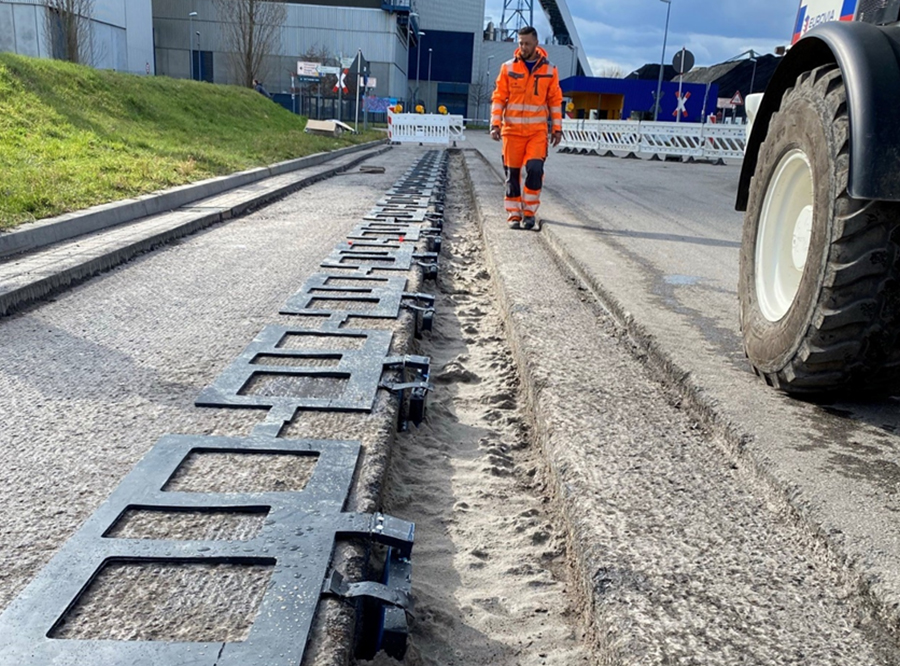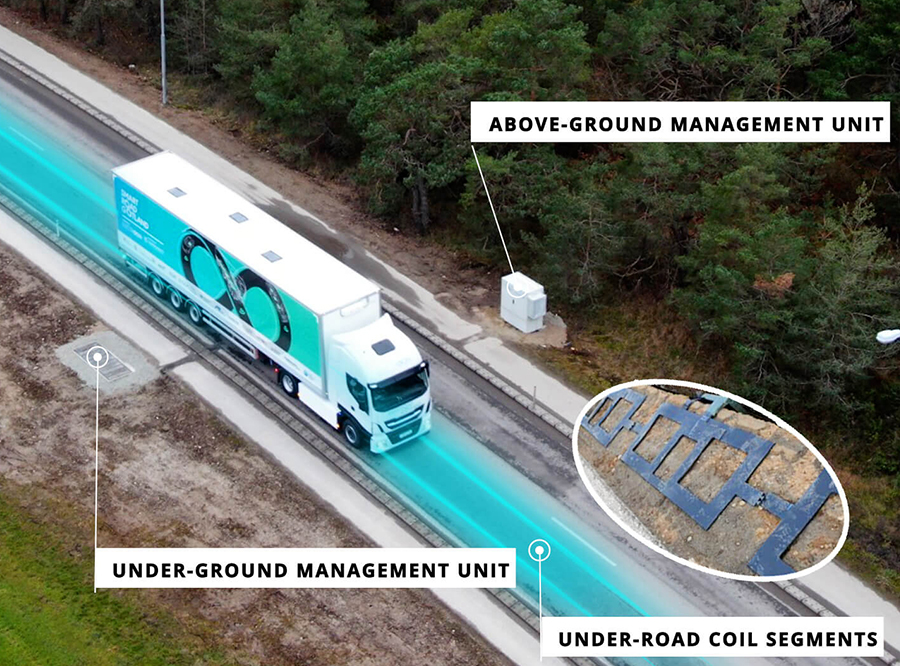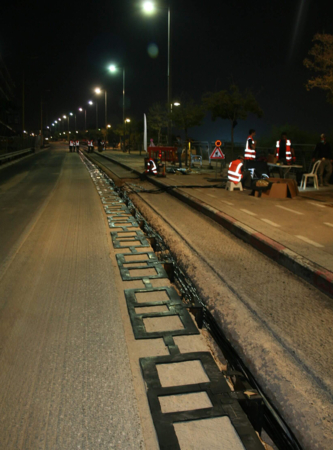In the Electric Fast Lane
Does the idea of charging your electric car battery as you drive sound like something from a movie or video game? Well think again, because inductive charging could soon become part of our everyday lives. Germany and other countries are already hard at work developing electrified roads.
It is 1990 and the legendary racing game F-Zero has just come out for the Super Nintendo Entertainment System. Anti-gravity gliders race each other around tight circuits, with risky overtaking maneuvers separating the winners from the losers. Right before crossing the finish line, the glider recharges its battery as fast as lightning on an energy strip – while driving at full speed and without even having to pit. What a feeling!
F-Zero marked a milestone in video gaming history, and the wireless charging of electric vehicles became part of pop culture. Fast-forward more than 30 years and inductive charging is no longer the stuff of science fiction, but already a reality on Germany’s roads. Are our national climate targets getting an electric boost?
Getting even more out of electric cars
The transportation sector is set to play an important role in the mission to achieve climate neutrality by 2045, with cars, trucks and so on accounting for one fifth of the nation’s carbon footprint. But there is little movement right now when it comes to the evolution of transportation. One could say that it is stuck in a jam. The German Federal Government wants at least 15 million electric cars on German roads by 2030. But there are still two obstacles standing in the way of this aspiration: the expensive purchase price and the vehicles’ limited range. Because no matter how much power the battery contains, on long journeys electric cars will still need to take extended stops at the electric charging station.
How does inductive charging work?
Dynamic wireless power transfer (DWPT) is the term used for the inductive or wireless charging of electric cars, whereby energy is transferred wirelessly between two copper solenoid coils. Experts are currently working on two solutions: a) wireless charging stations in parking lots; and b) electrified roads. Transmitter coils are embedded in the road, and the corresponding coupling coils are installed on the underbodies of electric vehicles. When they come into contact, an electromagnetic field is generated and the electric vehicle battery starts to charge. In principle, all vehicles – so cars, trucks and buses – can be fitted with DWPT receiver coils. All you need is enough space underneath the vehicle floor to fit the magnetic plate, which measures around 1.20 m by 70 cm.
Advantages and disadvantages of inductive charging
Inductive charging means that no cable is required. Solenoid coils are used in applications where cables are not practical. A large network of electrified roads and parking lots means that electric cars could one day be fitted with smaller batteries. Electric buses with fixed routes could be operated continuously, and electric trucks could cover large distances without stopping to charge.
But DWPT technology still has two disadvantages: low charging efficiency and comparatively high construction costs compared with conventional wired charging methods. Inductive charging speed is lower than for wired charging – not to mention the fact that, unlike with wired charging, the battery is not fully charged. This means that effective charging would require long sections of road with lots of coils so that they can work independently of one another and speed up the charging process.
Public and private transportation, the logistics industry
Imagine how great it would be if electric vehicles could recharge while they are driving along. It would be convenient and save time. The dynamic wireless power transfer (DWPT) process needed for this works in the same way as for smartphones and electric toothbrushes – only, in this case, for cars and on roads. Or rather, in roads – where integrated copper solenoid coils lie in wait for an electric car equipped with a coupling coil so that the car starts recharging when contact is made. The idea can be traced back to Nikolai Tesla, who was experimenting with wireless power transfer technology as far back as the late 19th century. His vision was still too big to become a reality at the time, but over a century later and Tesla’s ideas could potentially drive the innovation needed to accelerate the evolution of transportation.
Electrified roads are useful – particularly at traffic hubs and on busy roads – and would benefit public and private transportation and the logistics industry alike. Inductive charging complements wired charging and makes e-mobility more efficient and cost-effective: “The battery, which remains the most expensive part of an electric car, could be much smaller and lighter in the future because it would need to cover only short distances before the car reaches an electrified road,” said Dr. Alexander Kühl. He is a teacher in the field of manufacturing automation and production engineering at the University of Erlangen–Nuremberg (FAU). But the technology still needs to undergo extensive testing before it can be modified on a large scale for electrified roads.
“The battery, which remains the most expensive part of an electric car, could be much smaller and lighter in the future because it would need to cover only short distances before the car reaches an electrified road.”
– Dr. Alexander Kühl, teaches at the Friedrich-Alexander-University Erlangen-Nuremberg (FAU)
1,000-meter test road
ELINA, the first public wireless road project, was launched this year in the small German town of Balingen, southwest of Stuttgart. Electric buses shuttle back and forth between the railway station and garden show grounds, charging inductively as they go. Power supply company EnBW, which is based in Baden-Württemberg, partnered with the Balingen public utility company and Israeli start-up Electreon to install copper solenoid coils along a 1,000-meter stretch of road. Inductive charging stations were also installed at the bus stops at either end of the route.

“Public transportation provides the ideal setting for testing the capability of inductive charging for large vehicles because it involves defined routes over small areas,” said Alexander Pöllauer, Elina project manager for EnBW. “Since there are very few bus routes, the benefits of the wireless power transfer technology can be put to especially effective use.”

This is not the first inductive charging project for power supply company EnBW: “We gained some initial experience with the technology at our premises in Karlsruhe,” said Pöllauer. So the next logical step was to test the concept in the public domain. The company is also testing the effectiveness of the solenoid coils. “Around 70 kW is currently transferred to the three receiver coils in the bus. The amount of energy depends on factors such as crossing frequency, driving speed and waiting time at the inductive stops,” said Pöllauer. In tandem with this technical operation, the Karlsruhe Institute of Technology (KIT) is developing a planning tool for public electric bus networks. It is aiming to create a blueprint for cities all over the world for integrating electrified roads in transportation planning as efficiently as possible.
Inductively charged forklifts in the SMA Logistics Center
In our industry too, some companies have already started to reap the benefits of inductive charging: Since 2019, SMA Solar Technology AG – a specialist in photovoltaic and storage system technology – has been operating a number of inductively charged forklifts in the corridors of the warehouse facilities at its Logistics Center in Kassel. Just a short stop on a stationary electric transmitter coil – during loading or unloading, for example – is enough to initiate charging. This offers multiple advantages rolled into one: The forklifts are always ready for operation; the bulky replacement battery no longer needs to be carried around; and it is no longer necessary to perform the time-consuming and physically demanding task of changing the battery at the end of a shift, leaving employees with more time and energy to focus on their own activities.
Link to Video: Inductive charging for material-handling equipment and forklifts at SMA in Kassel.
Trip on the electric freeway
Inductive charging technology is attractive not only for public transportation but also for logistics and private transportation on freeways. The world’s first DWPT test road for electric trucks and buses has been in operation on the Swedish island of Gotland since 2020. Along a 1.6-kilometer stretch of road, multiple receiver coils charge the batteries as the vehicles travel at speeds of up to 80 km/h. Electreon recently expanded the project to include a stretch of road in the north of Sweden, allowing the company to test the DWPT system’s usability in the winter.
The E|MPOWER research project is seeking to mass-produce electrified roads. Next year, a 1,000-meter stretch of freeway in northern Bavaria will be equipped with copper solenoid coils, allowing anyone interested to try out the inductive charging technology from 2025 onward. A team led by Dr. Alexander Kühl from the University of Erlangen–Nuremberg (FAU) is developing a standard for the production and installation of solenoid coils. “We’re currently working on a host of processes and technologies for integrating the charging systems in roads made from lots of different materials.”


FAU in Erlangen–Nuremberg has been researching the development of inductive charging systems across various projects since 2010. “We see inductive charging technology as a potential solution for electrification in the transportation and logistics industry, which is known to account for the biggest share of CO2 emissions in the entire traffic sector,” said Kühl.
Inductive charging is becoming part of transportation planning
Inductive charging and electrified roads may soon become a smart addition to stationary electric vehicle charging, although room for improvement still exists when it comes to wireless charging power and speed. The technology is already demonstrating its potential in public transportation and the logistics industry – in other words, any setting in which vehicles operate along fixed routes. “Electric buses are traveling for longer without any interruption; logistics vehicles are transporting more while also requiring fewer charging stops,” said Kühl. But he believes “it will be quite some time” before the charging technology becomes established on a large scale. And before we get to that point, the technology first needs to have racked up many, many kilometers on electrified roads, and electric vehicles need to be fitted with the appropriate coupling coils. Audi, Nissan, VW and others are investing huge amounts of money and resources in the technology. VW, for example, wants to install a receiver coil in selected electric cars as standard by as early as 2024. Although building a one-kilometer stretch of electrified road currently costs anywhere between €2 and €3 million, “the electrification of roads could automatically be included as part of construction work going forward” – and as the perfect complement to the network of charging points.


